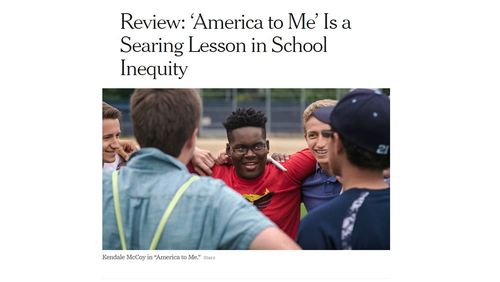
NYT: Why Blacks and Whites Behave Differently in Oak Park
By Steve Sailer
08/26/2018
As part of my continuing coverage of the Chicago suburb of Oak Park, from The New York Times:
Review: ‘America to Me’ Is a Searing Lesson in School Inequity
The word “inequity” is pushing out the word “inequality” on the grounds that “inequality” is too objective, whereas “inequity” presumes who is to blame for inequality (you) and who deserves a nice court settlement (not you).
By James Poniewozik
Aug. 24, 2018When does racial inequality begin? To answer the question, you could go back centuries.
But not millennia, definitely not millennia. Racial inequality began on the dock in Virginia in 1619 and not one second earlier. Tens of thousands of years of evolution on different continents couldn’t possibly have any influence on the present, whereas the impact of FHA redlining from 1937 to 1967 is immortal.
Or, as the empathetic, eye-opening documentary series “America to Me” does, you could go back to school.
The filmmaker Steve James, who followed two African-American high school basketball players in “Hoop Dreams,”
His famous documentary “Hoop Dreams” begins with a black 8th grader executing a 360 degree slam dunk. What white 8th grader can’t do that? So, obviously, that rules out human biodiversity as having any potential bearing on inequality in academic performance.
spent a year with students, teachers and parents at Oak Park and River Forest (O.P.R.F.) High School in suburban Chicago. In this integrated, progressive school he finds a community of white and black students whose education is not separate, but whose experience is not equal.
O.P.R.F. is the sort of school you might think would have race figured out better than others. In the 1960s, its community resisted white flight as black families moved in, along with liberal whites. Now, the school has a faculty conscious of diversity and reflective about bias.
But for all the good intentions, students of different races find themselves on different tracks, in different classes, with different outcomes, in a school that one teacher says “functions as two schools in one.”
The reasons are many and complicated — class, race, socialization, history — and this expansive, nuanced documentary tries to fold in all of them.
“America to Me,” which begins Sunday on Starz, …
(Most of the students followed are black. It was harder, Mr. James says in his narration, to get white students and parents to speak openly about race.)
… And while the worlds of these white and black high school students aren’t entirely closed off, they only overlap so much. Kendale McCoy, a student in the marching band, says he has some white friends, but he can’t talk to them about race. (We see some of his white bandmates asking him about his hair and touching it.)
Barack Obama was permanently traumatized by hair-touching, too.
Some of the most telling scenes take place outside class. At a football game, a referee tells the coach that the high school is getting more penalty flags because “your team just plays so aggressively,” though from what we see, they’re simply playing football.
And if you can’t trust the editor of a documentary to cut his hours of footage in a perfectly objective manner …
It’s one example of a phenomenon that plays out in viral-video confrontations and police encounters: The same behavior is perceived as more dangerous in black youth than it is in white youth. …
“America to Me” is full of moments like this, where you see how racial imbalances are perpetrated by people who don’t see themselves as perpetrating them. It just somehow happens, they believe. Technically.
